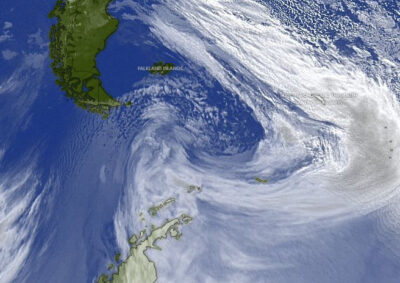Credit satellite image: Windy.com
Chilean polar station Eduardo Frei, located on King George Island, was hit this Wednesday, July 10, 2024, by a violent wind and blizzard storm associated with an extratropical cyclone that reached category AH-1 (Antarctic Hurricane 1) .
The sustained wind at the base reached 65 kt (75 mph or 120 km/h) and wind gusts throughout Sunday July 7 reached 78 kt (90 mph or 145 km/h). According to data from the meteorological station at Eduardo Frei station (WMO 89056), the temperature during the violent storm dropped to as low as -13ºC (10ºF). Atmospheric pressure dropped by 38 hPa in 24 hours, reaching 960.9 hPa.
The Bernardo O’Higgins meteorological station (WMO 89059) installed on the northern sector of the Antarctic Peninsula recorded even stronger winds, in the order of 87 kt (100 mph or 161 km/h). At the other end of the cyclone, in the Falklands Islands, sustained winds also reached hurricane values, reaching 64 kt (74 mph or 119 km/h) at Mount Alice station (WMO 88894).
The World Environmental Conservancy (WEC) has a 40-year archive of records of explosive cyclones that have hit King George Island, an important Antarctic location that houses research stations from 10 countries and an airport operated by Chile. Consecutive increases in the number of explosive cyclones have been recorded in the region; and now, we have recorded the first explosive cyclone since 1985 to reach the Antarctic hurricane category according to the specifications adopted by WEC.
******************************************************************************
According to research carried out in Antarctica by J. Turner and S. Pendlebury, some extratropical cyclones reach hurricane force because they interact and significantly intensify the katabatic winds coming from the interior of the Antarctic continent, producing some of the strongest winds on the face of the earth. An extratropical cyclone will be classified as an Antarctic hurricane if it meets the following conditions:
a) Location: the extratropical cyclone must be located south of latitude 50ºS, that is, in the Southern Ocean or on the Antarctic coast/continent;]
b) Low pressure center: must be 1000 hPa or less;
c) Winds: the cyclone must have sustained winds ≥ 33 m/s, ≥ 74 mph, ≥ 119 km/h or ≥ 64 kt. Wind gusts will not be considered.
d) The pressure drop in 24 hours must be at least 24 hPa, ie the cyclone must also be defined as an “Explosive Cyclone” according to Bergeron’s rules.

